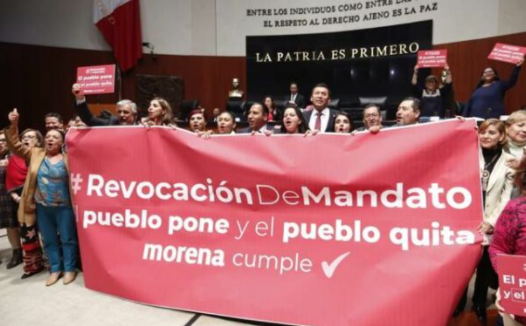The revocation of the presidential mandate referendum has been introduced in presidential systems as a mechanism of direct democracy, simultaneously with the referendum, plebiscite, participatory budget and citizen consultation. But, in practice, it operates more as a mechanism for measuring forces between the government and the opposition and as a thermometer of the popularity of the incumbent rulers.
Its incorporation, contemplated in few Latin American countries, appeared under leftist governments with a strong populist component: in Venezuela in 1999, in Ecuador in 2008, in Bolivia in 2009 and in Mexico in 2021. Although there is also a revocation for executive and legislative positions at the subnational level, a referendum to recall the presidential mandate is the one that captures the public’s attention.
The objective of the referendum is to submit the permanence of an executive in power to a vote of the citizens. It is presented as a control mechanism to reverse a previously established majority decision, but what are the reasons that justify voting to decide to maintain or remove a person from office?
Theoretically, it is based on an evaluation of the government’s actions from the moment it assumes office until it is subjected to such control. A positive evaluation implies continuity, and a negative evaluation implies leaving office. Empirically, it is difficult for citizens to have all the elements to make an evaluation, since the information on what governments do is asymmetric and practically monopolized by the political elites.
Therefore, citizens will be guided more by their political and ideological affinities and less by a performance evaluation. In contrast, in parliamentary or semi-presidential systems, a government’s continuity or not depends on the confidence of the members of parliament, who can revoke or confirm the permanence of the executive during its term.
Mandate revocation processes in Latin America
As of February 2022, only two presidential revocation processes had taken place. The first one in Venezuela, on August 15, 2004, was initiated by various sectors of the opposition in a coordinated manner, but also promoted by Hugo Chavez and his allies. Led by nonautonomous, not-very-independent electoral bodies, it ended up being a sloppy process that questioned its viability and ended up generating a political crisis.
Chávez remained in power by winning with 59.1% of the votes. From then on, and until his death in 2013, polarization increased in the country. Today, Venezuela—under the command of Nicolás Maduro—is considered an authoritarian regime, immersed in a serious political and economic crisis, and the revocation mechanism, which should have helped promote the exit of the ruler, didn’t work. In 2002 and 2016, the National Electoral Council (CNE) rejected the application of this mechanism by imposing unattainable rules.
The second process took place in Bolivia, on August 10, 2008, for the president, vice president and eight of the nine prefects. Evo Morales was ratified, with 67.43% of the votes, as well as six prefects, all of which belonged to the same party. Two of the removed prefects, from La Paz and Cochabamba, were members of the opposition.
Bolivia also entered a political crisis afterwards, as the referendum deepened the existing conflicts between regional leaders and the central government. Nine days after it was held, strikes and road blockades began, escalating the conflict to the point that an oil pipeline, which had been shut down by the opposition, exploded in September. Days later, peasants sympathetic to the government were murdered. Consequently, Morales expelled the U.S. ambassador, accusing him of supporting the opposition, and a state of siege was imposed in Pando, where the clashes were concentrated.
The conflict started to diminish when UNASUR intervened and commissions were created to investigate the events. Subsequently, and in less than a year, new processes were carried out to call Bolivian citizens to the polls. In January 2009, a referendum for the new Constitution was held, and in December of that year, general elections were held to elect a new president and other posts. In both processes, as with the revocation, Evo Morales and his movement won by a wide margin.
These experiences show that the referendum mechanisms for citizen control of power, albeit based on asymmetric information, is, therefore, a mechanism that elites can manipulate. Moreover, these processes tend to favor the incumbent leader and his party, and can eventually lead to political crises.
What is the purpose of AMLO’s revocation process?
In Mexico, the revocation of the presidential mandate was included in the constitution on December 20, 2019. In September 2021, the law was issued and on April 10 the referendum will be voted. To make the results binding, an absolute majority and a 40% voter turnout rate are necessary. Under these assumptions, and if the president obtains an unfavorable result, whoever occupies the presidency of the Congress would assume the executive power and, after 30 days, a substitute president would be appointed to complete the constitutional term.
It isn’t strange though, that López Obrador and his Morena party have promoted the revocation since in practice they presented it as a “ratification” of his mandate. At the same time, they have used it to attack the electoral authorities, particularly the National Electoral Institute (INE), denying it resources for carrying it out.
Unlike in the cases of Venezuela and Bolivia, in Mexico’s case the opposition, both partisans and non-partisans, haven’t mobilized their forces to promote the vote, so it could mean a “failure” for López Obrador, who has tried to generate broad mobilizations through other consultations with little success.
In a 2021 popular consultation to prosecute former presidents, barely 7.11% of voter turnout showed up, predictably winning the “Yes”, with 97.72% of them. In October 2018, three months after winning the general elections, López Obrador promoted a popular consultation—outside the law—to cancel the construction of the Texcoco international airport and build a new one in Santa Lucía. In this consultation, the president’s option won with a turnout of barely 1.22%.
Against this backdrop, all indicates that it is highly foreseeable popular participation for the revocation will be low and that the result will largely favor López Obrador. Perhaps, after this third experience in the region, it would be convenient to evaluate whether the revocation of the presidential mandate is really a mechanism of direct democracy or simply an instrument of manipulation of the political elites.
Translated from Spanish to English by Ricardo Aceves
Autor
Political Scientist. Professor at the University of Guanajuato (México). PhD. in Political Science from the University of Florence (Italy). His areas of interest are politics and elections in Latin America and modern political theory.











